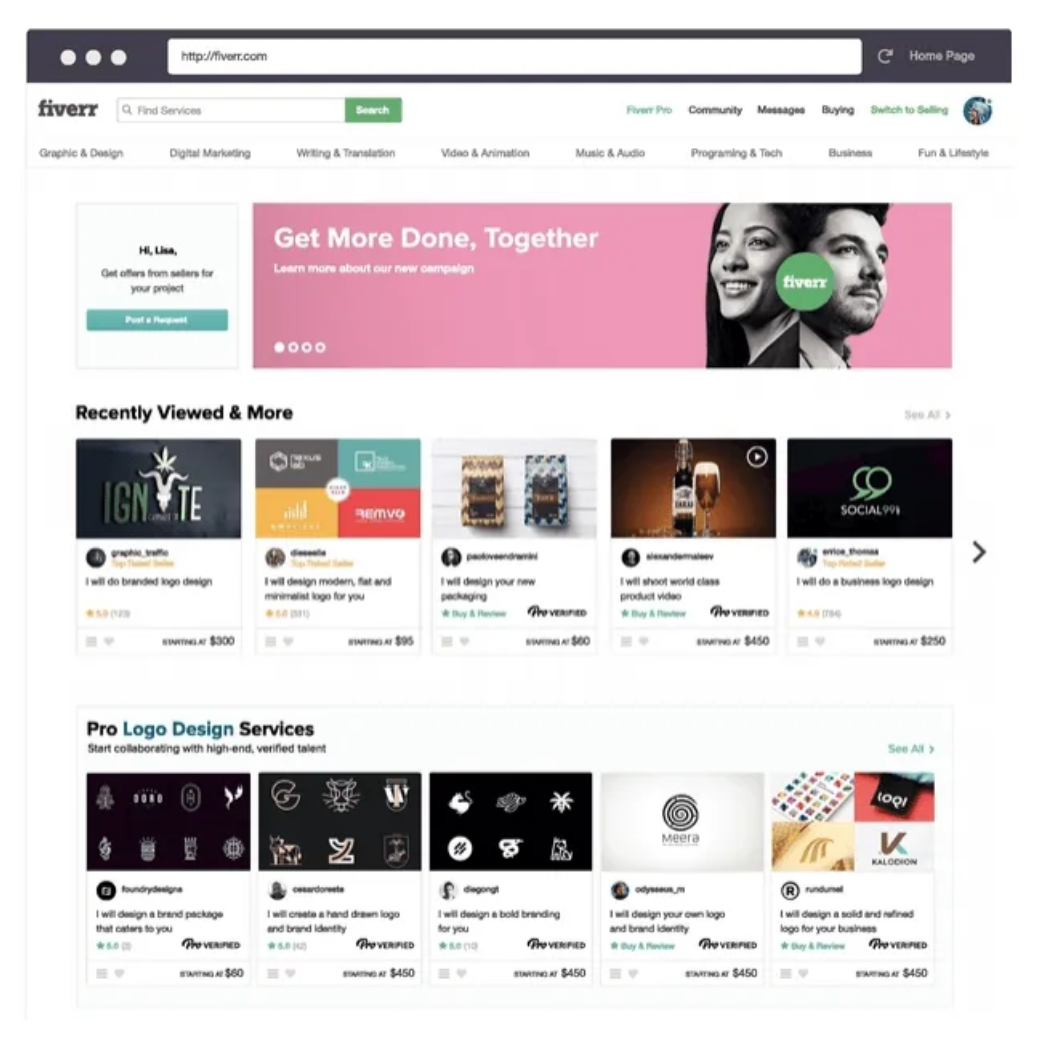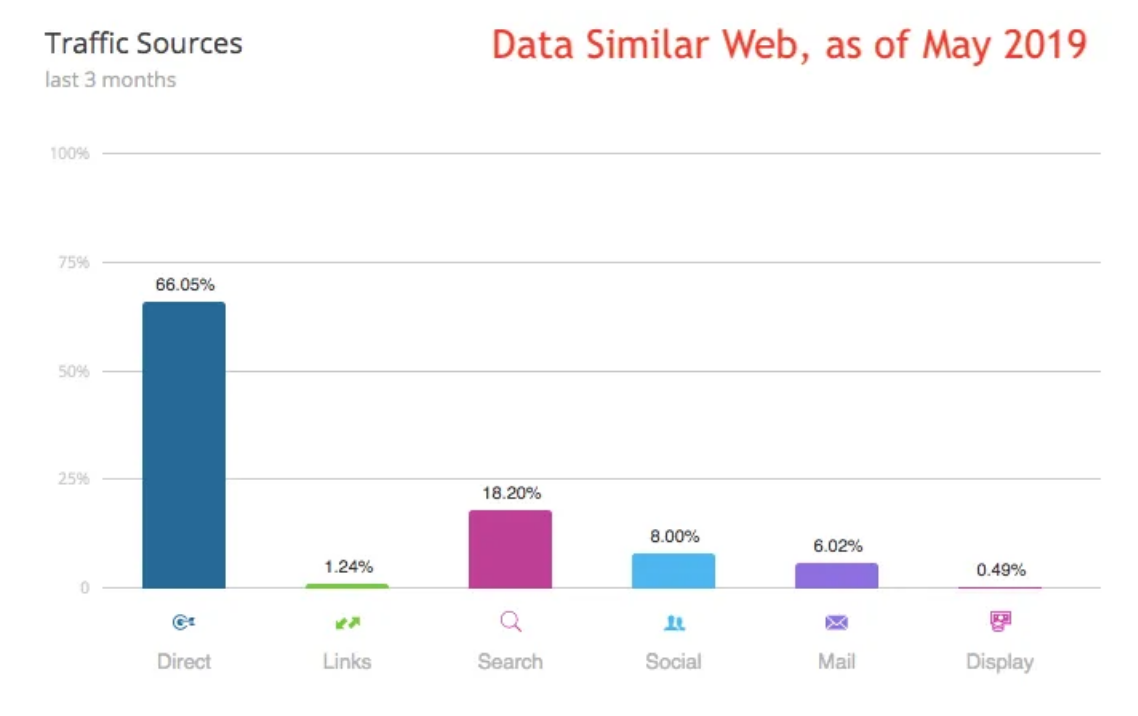Fiver's Business Model
Fiverr makes money primarily through transaction fees and service fees. The company follows a two-sided digital marketplace business models, where it needs to attract both buyers (SMEs businesses) and sellers (freelancers) that enable the platform to grow. The company looks at two key metrics for its growth over time, the repeat buyers and the spend per buyer over time.
Background story
Source: Fiverr F1 Form
Two Israeli entrepreneurs, Micha Kaufman, and Shai Wininger had an idea for a two-sided digital marketplace that could offer any “micro gig” on their platform. Thus, in 2010, they launched Fiverr. The marketplace went live in 2010, with a few live categories. Today Fiverr offers a set of services in many categories, that span from web design to editing, writing, development, and more.
Let’s look at its business model by starting from Fiverr mission statement.
Fiverr mission statement analysis
Our mission is to change how the world works together.
Starting from the mission statement helps understand where Fiverr unlocked customers’ value that helped it scale over time. Often this mission is a simple idea, which solves a simple issue.
Indeed, Fiverr started with the idea that people “should be able to buy and sell digital services in the same fashion as physical goods on an e-commerce platform.”
On the premise of that idea, Fiverr developed as a marketplace for digital goods and services, which got built similarly to e-commerce selling physical products, with a built-in efficient search and smoothness transaction process.
To understand what problems Fiverr solve we need to look at its value proposition and break that down.
Breaking down Fiverr value proposition
When a company successfully unlocks growth, that happens for several reasons, and the alignment of several factors. One of the key ingredients that help reach a scale is a real understanding of a problem to solve for a group of people. Be them a hundred, a thousand or over a million.
In most cases, to allow a business model to be viable, it takes more than just figuring out how to deliver a product and a service. And in many cases, a business model becomes viable only if it enables several players to gain something in the process of interacting with the organization that built and delivered that business model.
That something can be related to advantage, a pain relief, an emotional relief or else. But it needs to be designed to address several needs, based on the key players that will make the business successful in the first place.
For that matter, Fiverr two-sided digital marketplace business model has two key players:
Buyers: businesses of all sizes that need to outsource digital activities
And sellers: mostly freelancers looking for the opportunity to gain some financial freedom for themselves
It is important to remark that often those changes are part of broader societal and cultural changes, enabled by development in technology. Thus, when an organization spots a pattern that is affecting society, it can capture that to offer and craft its value proposition.
Some of the macro changes and trends that affected Fiverr success can be traced back to some key trends:
What Fiverr calls “Do-it-for-me movement,” or the willingness of professionals to outsource part of their work to freelancers
More companies relying on temporary talent, as digital platforms allow those organizations to hire freelancers on-demand
Flexibility and choice: freelancing grows in popularity as more professionals want to have the option of when and where to work
Technology and digitalization enable those shifts by allowing on-demand transactions from anywhere in the world
Fiverr value proposition to buyers
Source: Fiverr F-1 Form
(The buyers’ experience on the platform: Buyers can browse hundreds of services and look at reviews from other buyers to assess what is the most suited freelancer for the job)
The company points out five many values buyers get out of the platform:
Value for money: Through a frictionless platform with a wide array of digital services catalog with filtering functions, which reduced the time needed to find the right freelancer for the job
Extensive inventory of digital services: As of 2019, Fiverr offers 200 categories of services with prices ranging from $5 to thousands of dollars
A diverse pool of freelancers: As of 2019, the company has hundreds of thousands of freelancers with a broad set of skills
Clear price, the scope of work and quality of service: With a buyer-driven rating system provides the company claims to provide a “transparent quality rating mechanism” that allows making informed decisions
Trusted brand: The company focuses on dispute resolution, and customer service to enable repeat purchases on the platform
Fiverr value proposition to sellers
Source: Fiverr F-1 Form
(Example of The Seller Analytics Platform that enables sellers to track their progress and see all their transactions on the platform)
Maximise project pipeline: Fiverr directly matches freelancers with buyers who are looking for the service they provide so that they can focus on the service offering
Flexibility and control: Freelancers can offer their services when and from where they want
Frictionless payment processing
Credentialed storefront (seller page): Where freelancers can showcase their services. This is almost like a website, but easily manageable through the platform
Business support: Which helps sellers manage support to the customers acquired through the platform
Success management and support: Sellers also get support from the platform on managing their services, for instance with tools to track their performance over time
Unlocking the marketplace liquidity by generating network effects
The Amazon Flywheel or Amazon Virtuous Cycle is a strategy that leverages on customer experience to drive traffic to the platform and third-party sellers. That improves the selections of goods, and Amazon further improves its cost structure so it can decrease prices which spins the flywheel.
Marketplaces business models to be successful need to trigger a flywheel, what Amazon calls a virtuous cycle. In Fiverr’s case, that is the selection of available and competent freelancers on the platform.
To do that the company has used several injections of capital (the company got over a hundred million in total funding as of 2019) to inject liquidity on the offering side. Indeed, although the company popularised the term “Gig” which is a micro-transaction starting at $5, in 2011, so just after a year from its launch, there was the first transaction that passed the $5 mark.
In 2015, as Fiverr needed to expand its freelancers’ basis further, it allowed them to set their own minimum prices. Another critical metric the company uses to track its success is repeat buyers. Those that come to the platform and make more purchases throughout the year.
Thus, the Fiverr intended flywheel looks something like the following:
Seller supports services help freelancers worry only about providing a good service which attracts freelancers looking to make a living
Buyers can browse through hundreds of freelancers and look at their reviews and seller reputation to understand who will provide the best service at affordable price
Buyers complete transactions successfully
When completing transactions, they are offered discounts to refer the service
More buyers join in, and one-time buyers become repeat buyers
At the same time, sellers can further build their reputation on the platform
The seller base grows, which allows Fiverr to expand its catalog of “Gigs.”
Thus making the overall platform more valuable to users
And allowing more buyers to join in
Breaking down Fiverr overall business model
Fiverr makes money primarily through transaction fees and service fees.
As a marketplace model, the majority of Fiverr revenue comes from transaction fees and service fees based on the total value of transactions processed through the platform.
In 2018, the company made over seventy-five million dollars in revenues, and it operated at over thirty-six million dollars operating loss.
As a marketplace trying to grab shares of a new industry, Fiverr is in blitzscaling mode, and this can also be noted by the fact that as of 2019, the company spent over 65% of its revenues in sales and marketing activities. As the company has not a direct sales force, those expenses are driven primarily by aggregating online advertising spend across various channels, including search engine optimisation, search engine marketing, video and social media used for buyer acquisition:
Coherently with being a digital marketplace, Fiverr has an extensive digital reach, that enables it to attract almost forty million visits on the platform each month.
It’s important to remark that a company to have a viable business model it also needs to align its profit formula so that it can manage to have an efficient cost structure and processes that drive the growth over the years.
Fiverr revenue is diversified from a broad mix of digital services spanning across 200 categories, eight verticals that go from:
Graphics & Design,
Digital Marketing,
Writing & Translation,
Video & Animation,
Music & Audio,
Programming & Tech,
Business, and Lifestyle
Fiverr North Star metrics
Each company has to have a few key metrics to which it can measure the success of its business. Of course, each internal department will have different parameters, based on what processes they have control over.
For instance, the SEO department might look more at the organic traffic acquisition over time, or the conversion rates of buyers based on ads spending. However, at a financial level, the company has two key metrics to measure its success:
Repeat buyers
And spend per buyer
Indeed, in 2018, the company managed to grow its repeat buyers compared to first-time buyers:
Key takeaways
Fiverr follows a two-sided digital marketplace business model
It started by a simple idea: make it possible to purchase any digital service or goods, just like we do for physical stuff
As a marketplace, it grows on top of network effects. Those network effects can be engineered to create a flywheel or virtuous cycle of growth
Marketplaces usually rely on as many value propositions as many are the key players interacting on the platform. As a two-sided platform Fiverr has to offer a compelling value proposition to both buyers and sellers
As the company has not a direct sales force it spends most of its resources in acquiring buyers through digital acquisition channels, like search engine optimisation, search engine marketing, and social media
The company still runs at operating loss, which makes its business model still lacking the profit formula
Any company has to have a few key metrics to assess its success over time. Fiverr in particular looks at the repeat buyers and the spend per buyer as critical metrics












